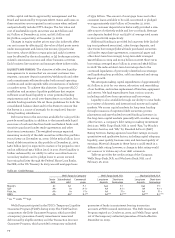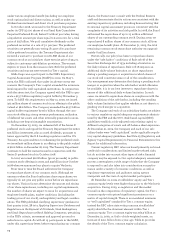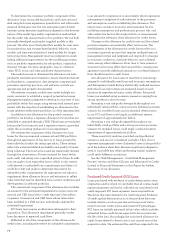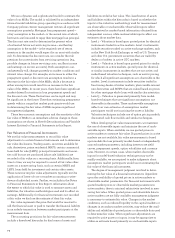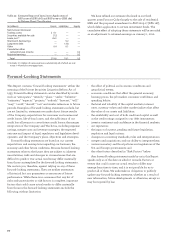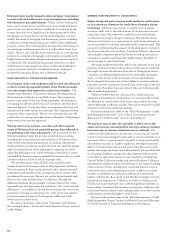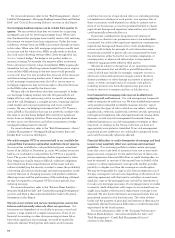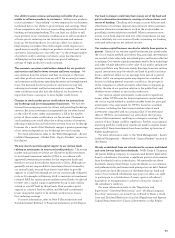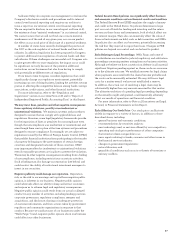Wells Fargo 2009 Annual Report Download - page 81
Download and view the complete annual report
Please find page 81 of the 2009 Wells Fargo annual report below. You can navigate through the pages in the report by either clicking on the pages listed below, or by using the keyword search tool below to find specific information within the annual report.
Table 32: Estimated Impact of Initial 2010 Application of
ASU 2009-16 (FAS 166) and ASU 2009-17 (FAS 167)
by Structure Type
Incremental Incremental Retained
(in billions, except GAAP risk-weighted earnings
retained earnings in millions) assets assets impact(2)
Residential mortgage loans –
nonconforming (1) $13 5 240
Commercial paper conduit 5 3 (4)
Other 2 2 27
Total $20 10 263
(1) Represents certain of our residential mortgage loans that are not guaranteed
by GSEs (“nonconforming”).
(2) Represents cumulative effect (after tax) of adopting ASU 2009-17 (FAS 167)
recorded to retained earnings on January 1, 2010.
The following accounting pronouncements were issued by
the FASB, but are not yet effective:
• ASU 2010-6, Improving Disclosures about Fair Value
Measurements;
• ASU 2009-16, Accounting for Transfers of Financial Assets
(FAS 166, Accounting for Transfers of Financial Assets –
an amendment of FASB Statement No. 140); and
• ASU 2009-17, Improvements to Financial Reporting
by Enterprises Involved with Variable Interest Entities
(FAS 167, Amendments to FASB Interpretation No. 46(R)).
Information about these pronouncements is further
described in more detail below.
ASU 2010-6 changes the disclosure requirements for fair
value measurements. Companies are now required to disclose
significant transfers in and out of Levels 1 and 2 of the fair
value hierarchy, whereas existing rules only require the dis-
closure of transfers in and out of Level 3. Additionally, in the
rollforward of Level 3 activity, companies should present
information on purchases, sales, issuances, and settlements
on a gross basis rather than on a net basis as is currently
allowed. The Update also clarifies that fair value measure-
ment disclosures should be presented for each class of assets
and liabilities. A class is typically a subset of a line item in the
statement of financial position. Companies should also pro-
vide information about the valuation techniques and inputs
used to measure fair value for both recurring and nonrecur-
ring instruments classified as either Level 2 or Level 3. ASU
2010-6 is effective for us in first quarter 2010 with prospective
application, except for the new requirement related to the
Level 3 rollforward. Gross presentation in the Level 3 rollfor-
ward is effective for us in first quarter 2011 with prospective
application. Our adoption of the Update will not affect our
consolidated financial results since it amends only the disclo-
sure requirements for fair value measurements.
ASU 2009-16 (FAS 166) modifies certain guidance contained
in FASB ASC 860, Transfers and Servicing. This pronouncement
eliminates the concept of QSPEs and provides additional
criteria transferors must use to evaluate transfers of financial
assets. To determine if a transfer is to be accounted for as
a sale, the transferor must assess whether it and all of the
entities included in its consolidated financial statements have
surrendered control of the assets. A transferor must consider
all arrangements or agreements made or contemplated at the
time of transfer before reaching a conclusion on whether
control has been relinquished. The new guidance addresses
situations in which a portion of a financial asset is transferred.
In such instances the transfer can only be accounted for as
a sale when the transferred portion is considered to be a
participating interest. The Update also requires that any
assets or liabilities retained from a transfer accounted for as a
sale be initially recognized at fair value. This pronouncement
is effective for us as of January 1, 2010, with adoption applied
prospectively for transfers that occur on and after the
effective date.
ASU 2009-17 (FAS 167) amends several key consolidation
provisions related to VIEs, which are included in FASB ASC
810, Consolidation. First, the scope of the new guidance
includes entities that are currently designated as QSPEs.
Second, companies are to use a different approach to identify
the VIEs for which they are deemed to be the primary
beneficiary and are required to consolidate. Under existing
rules, the primary beneficiary is the entity that absorbs the
majority of a VIE’s losses and receives the majority of the
VIE’s returns. The new guidance identifies a VIE’s primary
beneficiary as the entity that has the power to direct the
VIE’s significant activities, and has an obligation to absorb
losses or the right to receive benefits that could be potentially
significant to the VIE. Third, companies will be required to
continually reassess whether they are the primary beneficiary
of a VIE. Existing rules only require companies to reconsider
primary beneficiary conclusions when certain triggering
events have occurred. The Update is effective for us as of
January 1, 2010, and applies to all existing QSPEs and VIEs,
and VIEs created after the effective date.
We have performed an analysis of these accounting
pronouncements with respect to QSPE and VIE structures
currently applicable to us. Application of these new accounting
pronouncements will result in the January 1, 2010, consolida-
tion of certain QSPEs and VIEs that were not included in our
consolidated financial statements at December 31, 2009. Tables
32 and 33 present the estimated impacts to our financial state-
ments of those newly consolidated QSPEs and VIE structures.
Implementation of ASU 2009-17 (FAS 167) has been
deferred for certain investment funds and accordingly,
will not be consolidated under ASU 2009-17 (FAS 167).
Current Accounting Developments



